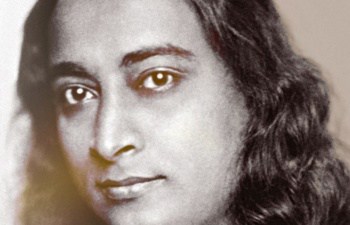And in one such moment Swami Kriyananda asked his Guru: “Master, will you be with us as much when you are gone as you are now?” A beautiful question, especially for all of us who never got to be physically in the presence of our Guru: Master’s response was very sweet and beautiful because there was no presumption to it. He said, “to those who think me near, I will be near.”
In this simple statement, Master very poignantly places the responsibility on the disciple, not so much on the guru, He does it very sweetly and not as an imposition. But then that’s the beauty of the guru; it’s never an imposition, it is always an invitation.
Sometimes, I enjoy posing impossible questions to myself , like, “Where is God?” Where are all the Masters? Where did they come from? They came into a body, were held for a little moment, but then where did they go?
Although I don’t recommend such questioning all the time, I do find, that every now and then, such thoughts are worthy of us to tune into and contemplate, especially as devotees and disciples. We naturally feel the need to keep drawing the Masters presence into our lives, but where are we drawing them from?
 The three-fold nature of God in the scriptures is defined as, Aum Tat Sat. In the Bible, Christ defines the same concept as the Father, the Son, and the Holy Spirit. Sat is God beyond creation. Tat means God individualized in every atom of creation.
The three-fold nature of God in the scriptures is defined as, Aum Tat Sat. In the Bible, Christ defines the same concept as the Father, the Son, and the Holy Spirit. Sat is God beyond creation. Tat means God individualized in every atom of creation.
Aum are the vibratory barriers that disguise God, hide Him and obscure Him from us. Aum is all creation. But more specifically, Aum are those vibratory elemental stages of creation (Ether, Air, Fire, Water & Earth), that subsequently hide and obscure that individualized God present in all creation.
Yogananda says, “every atom is God individualized.” But we are not able to perceive Him there. So let us further tune into this idea with an experience that we’re all very familiar with; that of the dream state.
Now let’s say I have a dream, and in this dream I’m roller skating by the ocean. It is my own consciousness that has created the vast ocean, and the beach, and every grain of sand. When we’re in the dream, it doesn’t feel fuzzy, or unreal. On the contrary it feels very real. If I were to grab that sand, I would feel the grannies and coarseness of the sand. I would feel every grain flowing through my hands.
Now back to the dream, the sun of course is shining, brilliant, beautiful and warm. I can feel its warmth on my skin. I can feel the wind on my face and the joy in my heart. Every aspect of this dream is a product of your consciousness. Created by it. Manifested by it.
And in the dream world too, eternally at play is the trinity – Aum Tat Sat. You’ve got Sat, which is you beyond the dream; that part of you that’s just sleeping in bed. You are not involved in this dream. You’re not actually on the beach.
There’s a portion of your consciousness that has gone out to create this dream world, but the majority of your consciousness rests still as a sleeping being. Often in the scriptures that’s how they depict God: Vishnu is sleeping and he is dreaming the world. In the Scriptures it says, God takes a portion of His consciousness and puts it into motion, which is where vibration comes and where Aum comes in.
So Aum is the entire dream creation itself: the sand, the wind, the sun, the ocean. That is all Aum, hiding the fact that it is just consciousness obscuring from us the understanding that this is not matter. This is not even vibration. This is purely a product of your consciousness.
And then in there is the YOU, which is the individualized portion of God manifested within the dream, even though all aspects of the dream are just as much the same consciousness. That is Tat.
 When the Masters come they live in this tri-fold nature of the Divine. The difference between us and them is solely this: we don’t know we are dreaming. Yoganandaji in his body comes from this tri-fold nature of awareness (God beyond creation, God in creation and creation itself).
When the Masters come they live in this tri-fold nature of the Divine. The difference between us and them is solely this: we don’t know we are dreaming. Yoganandaji in his body comes from this tri-fold nature of awareness (God beyond creation, God in creation and creation itself).
All the same consciousness, not different, but all exactly the same. When He comes into being He recognizes that a) he is connected to that consciousness beyond creation and b) his very consciousness also lives in every single atom. However, he is woven temporarily in this solid form where he holds a portion of his awareness to work through in this world.
They are omnipresence that has manifested momentarily for us. And when They let go of that dream they return back into that omnipresent state of being. When a Master says to us “to those who think Me near, I will be near,” what He is saying, is that by your thought you make omnipresence tangible. You draw and pluck me back out of the ether and you draw me right here.
That’s the power he has given to each of us. What Yogananda is trying to say to us, through this statement, is that we have the power to make Him real or unreal. And that was true for even when he was in his body.
A lot of people are enamoured by the idea of the guru in the body versus the guru beyond the body, and they often feel that they need to find somebody in the body. But what are you going to do with that body? It’s just free atoms that have been spun together. Have you understood Their consciousness? Do you daily pluck Them out of the ether?
Because where is Yogananda coming from when he says “to those who think me near I will be near?” Where does near mean, like just an inch or are we touching? He will come right into your own consciousness. He will break the barriers of creation itself. He will bypass the elemental stages of Aum and He will come straight into your consciousness, if you think of Him. That’s the role of the disciple; to keep plucking Him out of ether again and again.
All of us think of God and Gurus every day, in some way or the other. But do we feel that he’s actually responded? All the time? No, not really! We think of Them, and we move on. The true question for me is, what do you do after you think of Him? It’s like you’ve called on a friend and you say, “I need you right now. Just leave everything, and come to me!” And your friend comes running. He’s bursts through your door and says, “what happened? I’m here!” And you’re just tap away on your phone and ignoring him completely. So what do we do when we think of God? He comes instantaneously but we don’t do anything with His presence, do we?
Another beautiful conversation Master once had with a devotee who very sweetly said to him, “Guruji when I see you, I see only Divine mother.” Master looked at him and said, “then behave accordingly.” If Master were to walk through this door right now everybody would sit up and everybody would behave accordingly. But every time He comes into our consciousness, because we thought of him, do we behave accordingly, saying “I am now in the presence of my Guru?”
Thinking of Him means that you have plucked Him from the ether; you have made His consciousness real. Now what are you going to do about it? Do you then act accordingly? Do you then suddenly realize “oh my goodness. I’m in the presence of my Guru. I’m in the presence of God. I need to really be fully aware of this moment.”
 We know the story of Eklavya from the Mahabharat. He wanted to be Dronacharya’s student but Dronacharya could not teach him. So, Eklavya fashioned out a statue of Dronacharya. He learned and mastered the art of archery from that statue. One day Dronacharya was walking around and saw that somebody had perfectly shot these arrows, he realized that this person was better than all his students. He goes looking to find who this person could be, which eventually leads him to Eklavya.
We know the story of Eklavya from the Mahabharat. He wanted to be Dronacharya’s student but Dronacharya could not teach him. So, Eklavya fashioned out a statue of Dronacharya. He learned and mastered the art of archery from that statue. One day Dronacharya was walking around and saw that somebody had perfectly shot these arrows, he realized that this person was better than all his students. He goes looking to find who this person could be, which eventually leads him to Eklavya.
Eklavya falls at his feet and says, “Guruji, you have taught me everything. I made a little statue of yours and I learned from that statue.” Now how was Eklavya able to learn from a statue? Eklavya plucked Dronacharya’s consciousness out of the ether, which was omnipresent. And submitting himself to that consciousness, he acted accordingly and learned.
We have got a statue of our Guru. Every day we come and every day we infuse it with the Guru-tattva. But we don’t then act accordingly! So we don’t receive anything from this statue except the little bit that we are able to put into it.
Eklavya could learn to be the best archer from a lifeless statue. We wouldn’t be able to learn to be the best disciple from a “live” Guru either, because we don’t know how to act accordingly. We don’t know how to behave in the presence of God. We’ve not learned that art yet. We only know how to call.
So I’d like to leave us with this thought, bringing these two conversations together: to those who think me near I will be near but then, behave accordingly.

This has been transcribed from a talk by Tyagi Shurjo. You can watch the entire talk here https://www.youtube.com/live/d-oJ3uwTKEQ?feature=shared